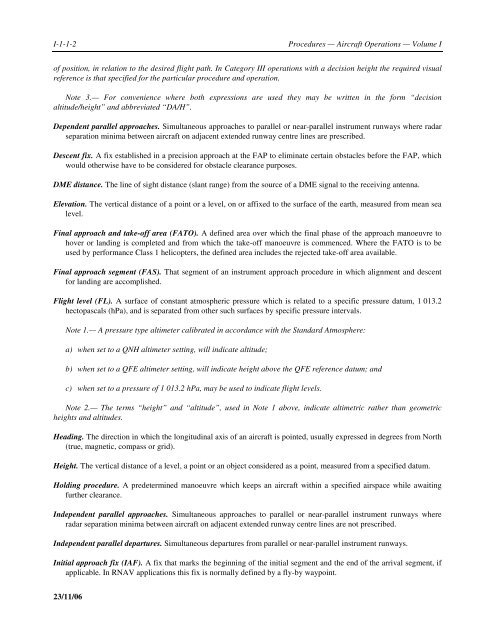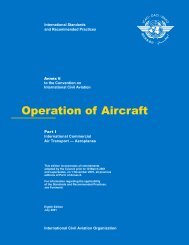Aircraft Operations
Doc 8168 Aircraft Operations, Volume I Flight Procedures
Doc 8168 Aircraft Operations, Volume I Flight Procedures
- No tags were found...
Create successful ePaper yourself
Turn your PDF publications into a flip-book with our unique Google optimized e-Paper software.
I-1-1-2<br />
Procedures — <strong>Aircraft</strong> <strong>Operations</strong> — Volume I<br />
of position, in relation to the desired flight path. In Category III operations with a decision height the required visual<br />
reference is that specified for the particular procedure and operation.<br />
Note 3.— For convenience where both expressions are used they may be written in the form “decision<br />
altitude/height” and abbreviated “DA/H”.<br />
Dependent parallel approaches. Simultaneous approaches to parallel or near-parallel instrument runways where radar<br />
separation minima between aircraft on adjacent extended runway centre lines are prescribed.<br />
Descent fix. A fix established in a precision approach at the FAP to eliminate certain obstacles before the FAP, which<br />
would otherwise have to be considered for obstacle clearance purposes.<br />
DME distance. The line of sight distance (slant range) from the source of a DME signal to the receiving antenna.<br />
Elevation. The vertical distance of a point or a level, on or affixed to the surface of the earth, measured from mean sea<br />
level.<br />
Final approach and take-off area (FATO). A defined area over which the final phase of the approach manoeuvre to<br />
hover or landing is completed and from which the take-off manoeuvre is commenced. Where the FATO is to be<br />
used by performance Class 1 helicopters, the defined area includes the rejected take-off area available.<br />
Final approach segment (FAS). That segment of an instrument approach procedure in which alignment and descent<br />
for landing are accomplished.<br />
Flight level (FL). A surface of constant atmospheric pressure which is related to a specific pressure datum, 1 013.2<br />
hectopascals (hPa), and is separated from other such surfaces by specific pressure intervals.<br />
Note 1.— A pressure type altimeter calibrated in accordance with the Standard Atmosphere:<br />
a) when set to a QNH altimeter setting, will indicate altitude;<br />
b) when set to a QFE altimeter setting, will indicate height above the QFE reference datum; and<br />
c) when set to a pressure of 1 013.2 hPa, may be used to indicate flight levels.<br />
Note 2.— The terms “height” and “altitude”, used in Note 1 above, indicate altimetric rather than geometric<br />
heights and altitudes.<br />
Heading. The direction in which the longitudinal axis of an aircraft is pointed, usually expressed in degrees from North<br />
(true, magnetic, compass or grid).<br />
Height. The vertical distance of a level, a point or an object considered as a point, measured from a specified datum.<br />
Holding procedure. A predetermined manoeuvre which keeps an aircraft within a specified airspace while awaiting<br />
further clearance.<br />
Independent parallel approaches. Simultaneous approaches to parallel or near-parallel instrument runways where<br />
radar separation minima between aircraft on adjacent extended runway centre lines are not prescribed.<br />
Independent parallel departures. Simultaneous departures from parallel or near-parallel instrument runways.<br />
Initial approach fix (IAF). A fix that marks the beginning of the initial segment and the end of the arrival segment, if<br />
applicable. In RNAV applications this fix is normally defined by a fly-by waypoint.<br />
23/11/06












